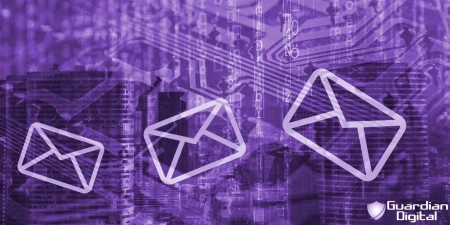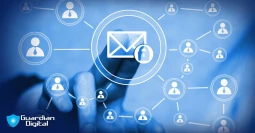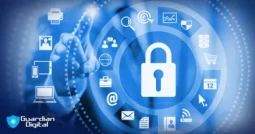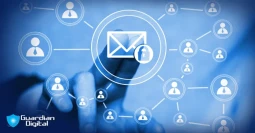Mastering Email Security: A Guide to Encryption & Protection

Various types of encryption technology work together to secure email communications, each with a specific role in protecting information. Familiarity with key protocols—TLS, PGP, S/MIME, MIME, STARTTLS, and DANE—can allow companies and individuals to secure their emails.
Secure Email Protocols
To ensure secure email communication, various encryption protocols are used to protect messages from interception and tampering. Below is a list of key protocols that help enhance email security and confidentiality.
TLS – Transport Layer Security & How Does it Work?
Imagine you are sending a sealed letter through a postal service. While it's in transit, it’s protected from being read by outsiders. However, once it arrives at its destination, the recipient can open and read it freely. This is the most common encryption protocol for securing in-transit email.
TLS encodes messages between mail servers, and no one can intercept and manipulate them during delivery. Most modern providers have TLS encryption. Messages will not leak when both sending and receiving servers use secure servers. TLS, however, doesn't secure messages at both ends, and messages can become readable for providers.
Why Use TLS?
Think of TLS as a secure highway for your emails to stay safe while traveling between mail servers. Just think of it—this prevents anyone from intercepting or tampering with your messages while they are in transit. No one can hack your emails to read or alter them. In our day and age, where emails are crucial for professional and personal communication, TLS plays a crucial role in keeping your emails safe.
PGP – Pretty Good Privacy 
Have you ever wondered if someone you don’t know—could be a hacker, government agency, or even your email provider? Unlike many email encryption methods that mainly secure messages when they’re in transit, PGP protects the entire email by encrypting the email itself. This makes it unreadable to anyone but the recipient. But how exactly does this work?
PGP provides full protection for the contents of an email message at both ends and utilizes asymmetrical encryption. Messages are encrypted with a recipient’s public key and decrypted with a recipient’s private key. Unlike other encryption methods, PGP often involves attaching the encrypted data as a separate file before sending the email. With PGP, a message can only become readable for an intended receiver, and it’s a preferred alternative for securing sensitive communications. However, key management can make it challenging for widespread use.
S/MIME – Secure/Multipurpose Internet Mail Extensions
Have you ever received an email that looked a little suspicious despite the fact that it came from a trusted sender? This is called Email spoofing, a common trick used by cybercriminals to trick people into sharing sensitive information. With S/MIME, senders can digitally sign their emails, proving their authenticity and preventing unauthorized tampering. But how exactly does this work?
S/MIME is yet another end-to-end encryption protocol enhancing security in emailing through message encryption and sender authentication through digital certificates. S/MIME varies in that it requires a certificate signed by a trusted Certificate Authority (CA). It brings an added security level but requires proper certificate management for companies.
MIME – Multipurpose Internet Mail Extensions
Email, as we know it today, has evolved beyond just text messages. MIME has made it possible for emails to carry multimedia content, transforming how we communicate across the globe. But what role does MIME play here? Let’s say you sent a document or spreadsheet via email and wondered how it got there. MIME is the function behind this. How does this technology work, and why is it so essential to modern email?
MIME is a standard format that extends emailing capabilities, allowing messages to include text, photographs, attachments, and multimedia. MIME doesn't have any form of encryption but is sometimes used in conjunction with an encryption protocol such as S/MIME for message content security. MIME supports complex structures in emailing, and encryption secures them. This is essential to modern email, as it has enhanced our communication and expanded how we share information.
STARTTLS – Opportunistic TLS Encryption
How can email providers ensure your messages are secure if they don’t always know what kind of encryption the recipient’s server supports? This is where STARTTLS steps in. Enabling opportunistic encryption allows email services to automatically upgrade to a more secure connection when the opportunity arises—without requiring both parties to agree in advance.
STARTTLS is an email security protocol that upgrades an unencrypted mail session to an encrypted session if both sending and receiving mail servers have TLS capabilities.
While STARTTLS enhances security by enabling encryption when possible, it does not guarantee encryption in all cases. If the recipient's server does not support TLS, messages may still be transmitted in plaintext, leaving them vulnerable to interception.
DANE – DNS-Based Authentication of Named Entities
Encryption is only as strong as the trust behind it. Despite the fact that an email is encrypted, how do you know you’re actually communicating with the right server and not an attacker? This is where DANE (DNS-Based Authentication of Named Entities) comes in. DANE helps solve this problem by verifying encryption certificates through DNS and ensuring secure connections between mail servers.
DANE enhances email encryption through TLS certificates used in emailing being authentic and not faked through an attack. With the use of DNSSEC (Domain Name System Security Extensions), DANE prevents man-in-the-middle attacks and aids in securing mail server connectivity.
How Secure Is Gmail? A Guide to Email Encryption for Business & Enterprise Users
Gmail is the go-to platform for millions of people who rely on it to make valuable connections and maintain professional communications. So, when it comes to privacy, how secure are your messages?
While Gmail is a strong base for all your personal and professional relationships, have you ever thought that your sensitive & personal information may be in the hands of someone else? Fortunately, Google provides tools like Client-side encryption (CSE) and S/MIME to help users keep their messages more secure—but how do they actually work?
First things first, Gmail does not encrypt emails by default, but users can improve security through Google's encryption options. Google offers two main encryption methods: S/MIME (Secure/Multipurpose Internet Mail Extensions) encryption and PGP (Pretty Good Privacy).
Other encryption options include Confidential Mode and Transport-layer security (TLS), including X.509 (Secure/MIME), AES-256 (Advanced Encryption Standard), and RSA-2048 (Rivest-Shamir-Adleman).
Let's start with examples of what could work best for you!
- S/MIME is best for businesses and schools using Google Workspace. It encrypts emails so that only the intended recipient can read them, but both sender and receiver must have it enabled.
- PGP is an advanced encryption method used mostly by individuals or organizations that require stronger security measures.
- TLS is best for general email users who want basic encryption for emails in transit but don’t require end-to-end encryption.
To learn more on this topic or how to enable S/MIME for your Gmail account, visit Google’s official guide.
Frequently Asked Questions About Email Encryption
How Does Email Encryption Work?
Email encryption works by encoding messages in a readable manner for approved recipients only. It uses asymmetric encryption (public and private keys) and symmetric encryption (shared keys).
What is the Difference Between End-to-End Encryption and Encryption in Transit?
End-to-end encryption (e.g., S/MIME, PGP) keeps only the recipient and sender in a position to view the message. Still, encryption in transit (e.g., TLS, STARTTLS) keeps messages secure only during transmission between mail servers.
Is Email Encryption Significant for Companies?
Yes. Email encryption keeps sensitive information secure, ensures compliance with laws (e.g., GDPR and HIPAA), and keeps messages secure from cyberattacks (e.g., loss of information and phishing).
Can Encrypted Messages be Hacked?
Although encryption enhances security, it is not unhackable. Weak passwords, private key vulnerabilities, and mail server vulnerabilities can expose encrypted messages. Secure security protocols and key management must be used.
Strengthening Email Security
Email encryption is a powerful security tool for securing communications, protecting sensitive messages, and providing tamper-evidence. Companies and individuals can secure emails and protect them from unauthorized access by utilizing TLS, PGP, S/MIME, STARTTLS, and DANE.
To even further secure your defenses:
- Use end-to-end encryption wherever possible.
- Configure your mail server to require strong encryption settings.
- Keep your security settings and encryption certificates updated regularly.
- Keep yourself abreast with changing threats and best practices in email security.
By taking these actions, your messages can be kept secure from intercept, information leaks, and cyberattacks.
Other FAQs
- What Is Guardian Digital EnGarde Cloud Email Security?
- FAQs: What Are Some Examples of Malicious Code?
- How to Properly Scan Your Windows Computer for Malware & Remove Malware from Your PC
- FAQs: What Are Denial of Service (DoS) Attacks?
- FAQs: Why Outsource Businesses Email Security?
- What Is Domain Spoofing?
- What Are Insider Threats & How Can You Reduce Your Risk?
- The Silent Assassins: How Impersonation Attacks Target CEOs via Email
- How Can I Choose the Right Email Security Service for My Organization?
- What Are the Benefits of Managed Security Services Providers (MSSPs)?



